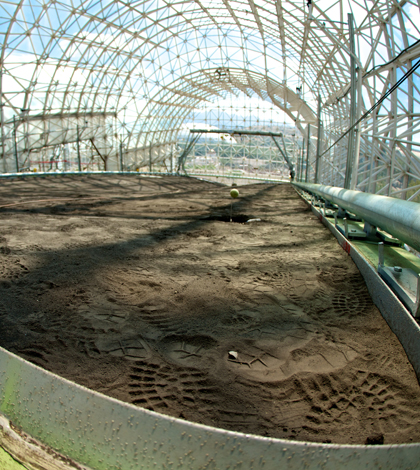Biosphere 2 observatory turns planetary clock back to zero to study surface changes

Land Evolution Observatory hillslope (Credit: Paul M. Ingram/Biosphere 2)
In early 1991, researchers were locked into Biosphere 2, a 3.14-acre experimental environment. They were left to survive within the indoor elements and successfully sustained for two years with minimal outside intervention. By 1995 the indoor ecosystem could not sustain itself by recycling air and water within the facility. Biosphere opened its doors and windows to let in fresh air in and ecological research.
Biosphere’s sealed earth experiment became extinct, but over the years the facility evolved into an indoor environment research station sealed under 7.5 million square feet of glass.
When the University of Arizona took over the massive indoor Earth in 2007 the science department wanted to optimize their unique resource. “We were challenged by the dean of science to come up with an idea and experiment that was totally new and could only be done at Biosphere 2,” said Peter Troch, science director of University of Arizona’s Biosphere 2.
After much discussion among professors and researchers across disciplines, the department decided to use Biosphere to look back at two fundamental components of the earth’s landscape: soil and water. While many events have shaped the earth, much of the riverine landscape was sculpted and transformed by rain running over and through the soil. It forms landscapes called hillslopes leading into rivers.
They decided to add to the Biosphere 2 creating the Landscape Evolution Observatory, so they could simulate how hill slopes evolved from the beginning.
“What if we could go back to time zero?” Troch said.
Hydrologists have been studying and modeling the evolution of landscapes for years, but this will be the first controlled, large-scale, long-term experiment to look at the evolution of a hillslope.
Three new additions in Biosphere 2 house massive troughs. Each sits on a 10 degree angle and is 11.25 meters wide and 29.60 meters long.
The troughs hold mineral-rich volcanic basalt that is one meter deep. The volcanic emission was chosen as researchers think it most closely resembles material that formed Earth’s landscapes and eventually became soil as we know it.

Construction underway on one of the Landscape Evolution Observatory troughs, which will enable scientists to better understand how water moves through different soil types (Credit: Paul M. Ingram/Biosphere 2)
Above the troughs, sprinkler systems simulate precipitation. Researchers will monitor infiltration of water into the soil and its movement beneath the surface. They expect that it will act as a catalyst for physical and chemical changes to the volcanic basalt. “We will see significant weathering and formation of clays,” said Troch.
A wide variety of sensors are implanted in the soil to measure changes in soil chemistry and water flow characteristics.
Ten highly sensitive load cells beneath each giant trough continually tracks the weight of the soil and water inside.
Nearly 500 soil and water potential sensors are in each hillslope. “These measure the pressure of water at local points and are important for determining the direction and velocity of water movement and can indicate the onset of water-stress for plants,” said Troch. “They measure pressures that are less than atmospheric pressure, indicative of water that is under suction due to capillary forces in the soil.”
Each slope also contains about 500 soil water content sensors and water samplers. Vaisala carbon dioxide sensors will measure carbon dioxide shifts in the soil.
Other sensors include 34 vibrating piezometers in the soil, which measure water pressure greater than atmospheric pressure. “It basically allows us to see if there’s a water table developing in the soil or not,” said Troch.
Nearly 1,000 soil-temperature sensors monitor temperature gradients in each slope. Water and gas samplers give researchers the ability to grab samples on-demand. Tipping bucket gauges track runoff from the slopes.

The Landscape Evolution Observatory is housed in the Biosphere 2 facility (Credit: Paul M. Ingram/Biosphere 2)
The entire experiment will run for about 10 years. It will start with watching soil weather and develop. Then the researchers will add seeds to the hillslopes to see how plants affect water flow, retention and soil.
One hillslope is fully operational with sensors deployed in and above the soil. Researchers are using it as a starting point to determine how to finish preparing the other two for long-term experimentation. They plan to start long-term simultaneous experiments for all three this summer.
Troch said researchers spent a long time modeling and designing the experiment before building the slopes. Still, there is uncertainty as an experiment at this scale has never been performed.
He said one outcome he hopes to generate is interest and participation among the scientific community.
Image: Land Evolution Observatory hillslope (Credit: Paul M. Ingram/Biosphere 2)




0 comments